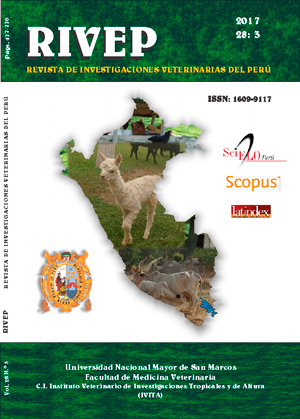Zoonotic parasites in frogs used for preparing beverages for human consumption in Lima, Peru
DOI:
https://doi.org/10.15381/rivep.v28i3.13290Keywords:
parasites, frogs, Gorgoderina attenuata, Cryptosporidium sp, zoonotic, beveragesAbstract
This study was conducted to evaluate the contamination for parasites in the frog Telmatobius jelskii, used in the preparation of extracts intended for direct human consumption in the form of beverages expended in public areas. Frogs (n=84) were taken in 21 food carts in Lime city center. Direct coproparasitological techniques and the Travassos technique were used for the detection of gastrointestinal parasites. For the detection of metazoan parasites the small and large intestine, liver, lung and bladder were revised. All frogs had parasites of at least three species, identifying the presence of two digenea: Gorgoderina attenuata (7.2%) and Gorgoderina sp (11.9%), two nematodes: Hedruris heyeri (100%) and Capillaria sp (6.0%) and two zoonotic protozoa: Cryptosporidium sp (100%) and Balantidium sp (100%). The results showed high contamination with parasites in frogs that are used in the preparation of extracts, which implies a risk of infection for consumers if considering that extracts were prepared with whole frogs that are not are not subjected to cooking processes.Downloads
Downloads
Published
Issue
Section
License
Copyright (c) 2017 Enrique Serrano-Martínez, Marco Quispe H., Lucy Plascencia P., Elizabeth Hinostroza M.

This work is licensed under a Creative Commons Attribution-NonCommercial-ShareAlike 4.0 International License.
AUTHORS RETAIN THEIR RIGHTS:
a. Authors retain their trade mark rights and patent, and also on any process or procedure described in the article.
b. Authors retain their right to share, copy, distribute, perform and publicly communicate their article (eg, to place their article in an institutional repository or publish it in a book), with an acknowledgment of its initial publication in the Revista de Investigaciones Veterinarias del Perú (RIVEP).
c. Authors retain theirs right to make a subsequent publication of their work, to use the article or any part thereof (eg a compilation of his papers, lecture notes, thesis, or a book), always indicating the source of publication (the originator of the work, journal, volume, number and date).










